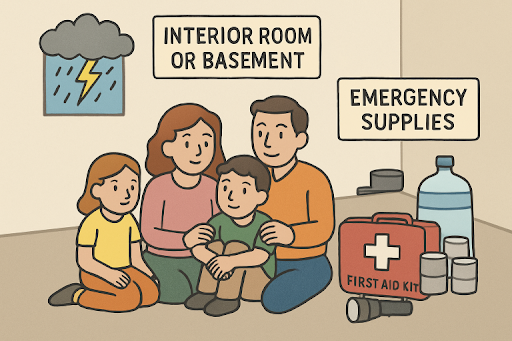Key Takeaways
- Identify and prepare a safe shelter area in your home.
- Equip your shelter with essential emergency supplies.
- Stay informed through multiple alert systems.
- Practice regular emergency drills with your family.
- Understand post-storm safety procedures.
Table of Contents
- Introduction
- Choosing the Right Shelter Location
- Essential Supplies for Your Storm Shelter
- Staying Informed During Severe Weather
- Conducting Regular Emergency Drills
- Post-Storm Safety Measures
Introduction
When tornadoes, thunderstorms, and other forms of severe weather threaten, your safety depends on how well you prepare in advance. Identifying safe spaces, stocking up on essential supplies, participating in regular emergency drills, and staying informed are vital. Securing a reliable Tulsa tornado shelter can significantly enhance your family’s protection and peace of mind if you reside in a high-risk region like Oklahoma.
Severe weather events can escalate rapidly, so clear planning and swift action are essential. In addition to equipping your shelter, understanding post-storm safety and learning how to communicate with local authorities will help you recover more quickly and securely. From choosing the right shelter location to maintaining up-to-date alerts, every step is critical to weathering the storm.
According to the U.S. Department of Homeland Security, families preparing for emergencies are far more likely to stay safe and calm and take the right actions during a crisis. Preparation minimizes panic and confusion when every second counts.
Clearly outlined steps, regular practice, and family involvement are the cornerstones of storm safety. Preparing ahead of time can dramatically improve your odds of staying unharmed and recovering swiftly after a severe weather event.
Choosing the Right Shelter Location
The effectiveness of your storm safety plan begins with the selection of a secure shelter. Underground basements or purpose-built storm cellars remain the gold standard for tornado protection. If an underground space isn’t available, identify an interior room on the lowest floor of your home. Avoid rooms with windows and stay away from exterior walls. A centrally located bathroom or closet often offers the best protection.
The National Weather Service confirms that an above-ground, reinforced safe room offers reliable protection—a key consideration for those who do not have basements. When choosing a site, check that it is free from heavy, unsecured items that could become dangerous projectiles during a storm. Review FEMA’s guidelines on safe rooms for additional insights: FEMA Safe Room Guidance.

Essential Supplies for Your Storm Shelter
A properly equipped storm shelter should keep you and your loved ones safe, fed, hydrated, and informed, even if you’re cut off from outside help for a few days. Your emergency kit should include:
- At least 72 hours’ supply of non-perishable food and bottled water.
- A battery-powered or hand-crank radio for weather updates.
- Flashlights with extra batteries.
- Comprehensive first aid kit.
- Personal hygiene essentials, including sanitation supplies.
- All prescription medications and any medically required items.
- Sturdy shoes, gloves, and protective clothing for post-storm clean-up.
- Emergency blankets, baby supplies, and pet necessities as needed.
- Copies of critical documents in a waterproof bag or container.
Keep all shelter supplies packed and easily accessible. Regularly check and refresh them, especially food, water, and batteries, to ensure everything remains up to date and in working order.
Staying Informed During Severe Weather
It’s critical to receive real-time alerts about severe weather threats. Rely on a combination of sources, as cell service or power can fail unexpectedly. NOAA Weather Radios are a reliable staple, providing direct updates from the National Weather Service even when other networks are down.
Supplement radio alerts with trustworthy mobile weather apps and tune in to local news broadcasts for region-specific guidance. The redundancy of multiple information sources is vital, particularly during overnight hours or when you may not be actively monitoring the weather. The Centers for Disease Control and Prevention emphasizes that always having more than one way to receive warnings is essential for your family’s safety.
Conducting Regular Emergency Drills
Practicing what to do before disaster strikes helps cement the correct response and minimizes confusion. Schedule regular emergency drills, ensuring everyone in your household knows the quickest and safest route to the shelter. Assign roles where necessary—such as who is responsible for gathering younger children, pets, or grab-and-go supplies.
After each drill, discuss what went well and use feedback to refine your plan. By rehearsing these scenarios several times a year, your response will become second nature, especially important for children or elderly family members who may need extra help.
Post-Storm Safety Measures
When the storm passes, do not exit your shelter until you’re sure it’s safe and you have confirmation from official sources. While inspecting your home and property, be highly cautious of hazards such as downed power lines, broken glass, exposed nails, and contaminated flood waters.
Wear sturdy shoes and gloves, and beware of gas leaks or structural damage before re-entering any building. Notify authorities immediately if you discover significant risks or emergencies, so professional help can reach you and your neighbors as quickly as possible.
Document any damages for insurance claims and check on neighbors’ welfare, particularly those who are elderly or have limited mobility. Your vigilance and caution in the aftermath of a severe weather event are just as necessary as your preparation beforehand.
By understanding the risks and implementing these storm shelter safety tips, you significantly improve your chances of staying safe and emerging resilient from even the harshest severe weather events.



